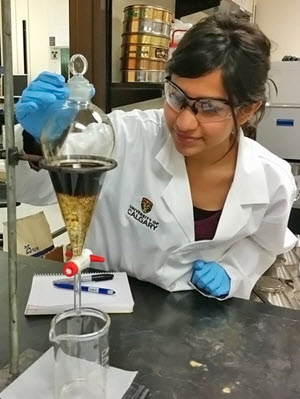
Aprami Jaggi conducts bench top oil-water partitioning experiments. (photo credit: Kim Nightingale)
As a child in India, Aprami Jaggi witnessed firsthand how polluted water sources impact society.
Her desire to make water remediation her life’s work has led her from Delhi to Calgary, Canada, to study oil mitigation. There she combines geochemistry and geophysics to hunt for scientific answers and practical solutions to the worldwide water pollution problem.
Pursuing a Ph.D. in geosciences at the University of Calgary, Aprami is a GoMRI Scholar with the C-IMAGE consortium. She talks about her journey around the world to gain the knowledge required to help her homeland.
Her Path
“I believe that my very first trip to the National Science Museum resulted in my initiation into science,” Aprami said of her first childhood visit to India’s flagship science museum. “This was followed with ‘100 science experiments for kids’ and lots of exhibitions.” She recalled spending weeks filling buckets from a tanker to cope with a clean water shortage. Getting water this way gave Aprami direction to her growing passion for science. “The abysmal condition of the rivers in the city and the continuing pollution inspired me to work towards water remediation.”
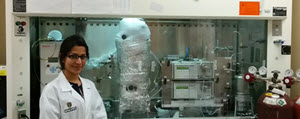
Aprami stands with the customised partition device used to experimentally simulate oil spill conditions. (photo credit: Kim Nightingale)
Aprami studied environmental engineering at the University of Delhi, where she worked on natural water bioremediation projects and sampled the Yamuna River to identify industrial input hotspots. An internship and subsequent job at Nalco-Champion, an Ecolab Company, introduced her to the industrial capabilities of water treatment. There she helped develop chemistries tailor-made to the respective problem, a direction she decided to pursue further academically.
“At my time in Nalco-Champion, I had heard about the game-changing ideas of Dr. Steve Larter and Dr. Thomas Oldenburg’s group,” she said, adding that their ideology of applied sciences supported her vision of change through research.
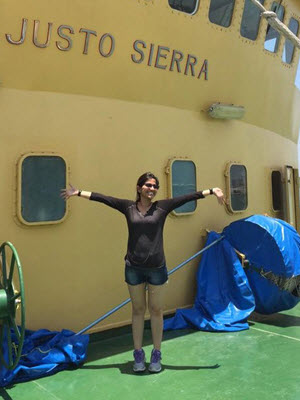
Aprami saw the ocean for the first time in July 2015 when she boarded the Justo Sierra on a cruise she organized. (photo credit: Sara Lincoln)
Larter’s TEDx talk about rethinking the world’s need for fossil fuels inspired her to contact the two researchers and see if their program would be a good fit with her academic studies and water remediation experience. They offered her a position on the C-IMAGE project to study Deepwater Horizon oil spill impacts on the Gulf of Mexico. She travelled halfway across the globe and began her Ph.D. in September 2014.
Her Work
Aprami is looking at how low molecular-weight, toxic oil compounds such as benzene and toluene enter and travel through the water column. Because traditional measurement methods cannot account for high pressure and low temperature extremes in deep sea conditions, her team built a specialized instrument to measure these compounds’ distribution trends under deepwater blowout conditions. They customized the device using methane-charged oil or ‘live’ oil to simulate dissolved gases’ release during a spill. Initial results, which she presented at the 2016 Gulf of Mexico Oil Spill & Ecosystem Science Conference, indicated methane’s inclusion greatly influences the amount of toxic oil elements that enter the marine environment. The data the device generated will help create future distribution models of toxic pollutants migration through water. She is preparing her first paper for an international peer-reviewed journal about how oil components partition into the water column under various temperature and pressure conditions.
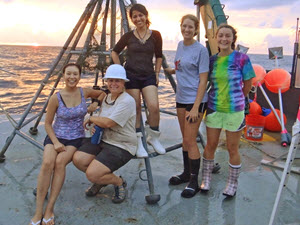
The all-female science party, Aprami in center, aboard the R/V Weatherbird II in August 2015. (photo courtesy of C-IMAGE)
Aprami also is investigating the fate of oil compounds from the 1979 Ixtocand 2010 Deepwater Horizon oil spills. She collected water samples last summer in areas these spills impacted and is analyzing the molecular structure of dissolved organic matter to understand long term oil fate. “I was onboard the Justo Sierra and Weatherbird-II a week apart,” she recalled. “I covered over 20 different sampling sites and collected samples at different depths using Niskin bottles, while measuring the temperature, conductivity and oxygen profile of the water column.”
Aprami, who had never before seen the ocean, organized the sampling trip to Mexico. Her first expedition lasted 17 days, sampling 12-16 hours per day and helping other research groups on board. She arrived in St. Petersburg, Florida, and began a 5-day sampling effort in the northern Gulf. Afterwards, she organized shipping of the equipment to Sachs Harbour, Northwest Territories, Canada, where another research group took Arctic water samples for comparison studies.
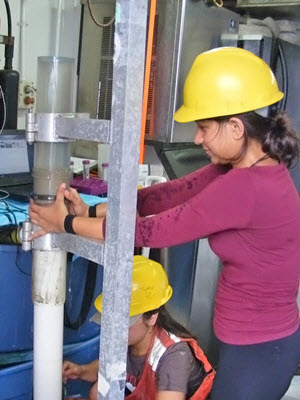
Aprami transferred and extruded core sediments on board the Weatherbird II in August 2015. (photo courtesy of C-IMAGE)
She shipped the Gulf samples to Calgary and analyzed them using Fourier transform ion cyclotron resonance- mass spectrometry (FTICR-MS). FTICR-MS can resolve complex molecular mixtures and provide the elemental composition of individual compounds, making it ideal for molecular fingerprinting the extremely complex makeup of the oceans’ dissolved organic matter (DOM). The comprehensive DOM screening helps researchers analyze compounds that are poorly understood in terms of environmental and human health impacts and enables tracing of contamination sources. For example, DOM in natural waters near oil seeps and spill sites may represent near terminal degradation petroleum products.
Her Learning
Aprami learned the importance of the research process, which gives scientists tools to persevere, particularly when developing new experimental protocols: “The execution of every big idea starts small. For example, before you take on the big fancy equipment, you have to perfect the art of washing glass ware. Each step along the way is important to reach the end goal.”
She feels fortunate to be part of the GoMRI community, saying the close knit research group working towards a common goal provides a unique opportunity for interdisciplinary and interinstitutional collaboration. “Being a part of C-IMAGE, I get to work alongside people from 19 institutions and 5 different countries,” Aprami explained. “Without GoMRI, such collaboration wouldn’t have been possible.”
Her Future
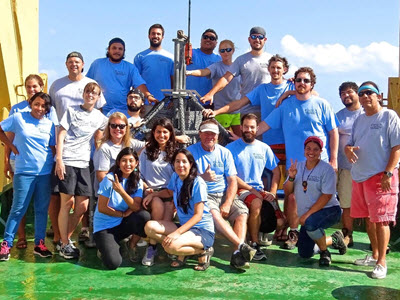
The science party on board the Justo Sierra, July-August 2015. (photo courtesy of C-IMAGE)
Aprami plans to complete her Ph.D. in 2018 and pursue a corporate research and development position to help find practical answers to worldwide water pollution problems
“Having been a part of the R&D section in the industry, I realize that although the prospect of ‘blue sky research’ is exciting, we need more and more scientists working on providing real world solutions to existing problems,” she explained.
Praise for Aprami
Aprami’s advisors Steve Larter and Thomas Oldenburg described her as a key team member, both scientifically and socially. She immediately impressed the C-IMAGE administration, who named Aprami their Student of the Month shortly after she arrived in Calgary. She has won additional awards and accolades since, including being asked to give an oral presentation at the 2016 Gulf of Mexico Oil Spill & Ecosystem Science Conference.
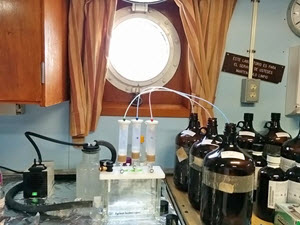
Aprami’s lab equipment for extracting dissolved organic matter from water samples on board the Justo Sierra. (photo credit: Aprami Jaggi)
“Considering that Aprami’s previous studies and experience were not geology or geochemistry related, it is remarkable how deep her technical knowledge is already at this stage,” said Oldenburg. He and Larter acknowledged her exceptional speaking and writing skills, but said her deep scientific knowledge makes her a rising star, “She not only developed special extraction methods usable under limited lab conditions such as cruise ships but also learned in this short time how to operate the unique partition device, GC-MS, LC-MS, and FTICR-MS and how to interpret these diverse data sets.”
Aprami especially impressed her advisors when she organized the research mission into Ixtoc-impacted Gulf waters, overcoming the language barrier with the Mexican crew among other challenges. They reported that many other cruise members expressed how enthusiastically she helped the team in addition to tending to her own sampling. “Aprami has excellent interpersonal skills, works very hard, is very organized, joins and partially organizes many social events within our research group,” Larter summed up. “Aprami is an all A+ student!”
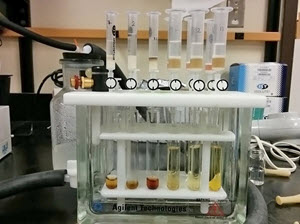
Aprami’s more elaborate lab set up at her lab in Calgary. (photo credit: Aprami Jaggi)
The GoMRI community embraces bright and dedicated students like Aprami Jaggi and their important contributions. The GoMRI Scholars Program recognizes graduate students whose work focuses on GoMRI-funded projects and builds community for the next generation of ocean science professionals. Visit the C-IMAGE website to learn more about their work.
************
This research was made possible in part by a grant from The Gulf of Mexico Research Initiative (GoMRI). The GoMRI is a 10-year independent research program established to study the effect, and the potential associated impact, of hydrocarbon releases on the environment and public health, as well as to develop improved spill mitigation, oil detection, characterization and remediation technologies. An independent and academic 20-member Research Board makes the funding and research direction decisions to ensure the intellectual quality, effectiveness and academic independence of the GoMRI research. All research data, findings and publications will be made publicly available. The program was established through a $500 million financial commitment from BP. For more information, visit http://gulfresearchinitiative.org/.
